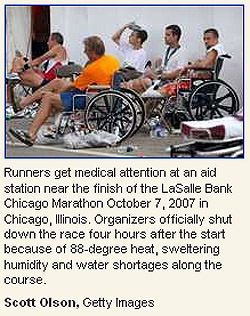The lights went out for Paul Krumrich 25 miles into his marathon, head swirling, knees buckling, body flopping to the asphalt of Summit Avenue in St. Paul as daylight faded to black. It was Oct. 7, a bit after 11 a.m. on the penultimate mile of the Medtronic Twin Cities Marathon. Krumrich, 34, was on pace to complete his first 26.2-mile run in time for a late-morning victory lunch. He ended up in the hospital instead.
Thus starts my story in today’s Minneapolis Star Tribune, where I look at two recent marathons on Oct. 7 that descended into near chaos due to unusually-warm temps and masses of heat-suffering runners.

In Chicago, where the LaSalle Bank Chicago Marathon attracted about 36,000 runners on Oct. 7, nearly 200 runners required hospitalization, a dozen admitted in critical condition. Hundreds were treated for heat ailments on the course. Aid stations were overwhelmed, with water running dry and cups unavailable for competitors in the back of the pack.
Then, as temps rose in Chicago to 88 degrees with 81 percent humidity, the course director shut down the race at the halfway point, moving in emergency vehicles, air-conditioned city buses, hovering helicopters and bullhorn-wielding policemen to remove the nearly 10,000 remaining runners from the course. Chad Schieber of Midland, Mich., was pronounced dead after nearly completing the race; an autopsy later revealed that a heart defect, not heat, had killed the 35-year-old competitor.

“That Sunday in early October was a perfect storm,” said Ryan Lamppa, a researcher with Running USA, a nonprofit clearinghouse that tracks data on marathons.
Participation in marathon running continues to soar in the U.S., where last year about 410,000 people completed the 26.2-mile challenge. But is this populist tilt a good thing? Big marathons involve planning akin to a military operation, with thousands of workers and a massive force of police and medical personnel moving small cities of 20,000 or more people through elaborate urban courses. Managing so many people at their physical and mental limits can be daunting, and, some argue, dangerous.
“It’s a new marathon world,” said Lamppa. “The sport has changed dramatically from its roots 20 or 30 years ago, when I think the distance drew more respect.”
Go here (https://www.startribune.com/1244/story/1488300.html) to see the full story on the Marathon Meltdown of October 7.






